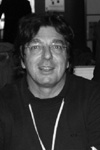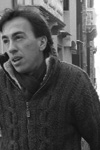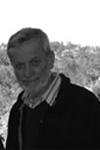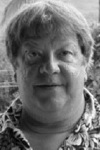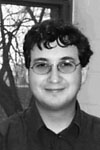principles of fluorescence techniques
june 25-29, 2007 | genova, italy
Prof. Alberto Diaspro | University of Genova | Department of Physics | Nanoscopy and NIC@IIT | 16146 Genova | Italy | Tel: +39-0103536426 | diaspro@fisica.unige.it
Alberto Diaspro is Director of the Department of Nanophysics at the Istituto Italiano di Tecnologia (IIT), Deputy Director of IIT, Chair of the Nikon Imaging Center at IIT (www.nic.iit.it). Diaspro is Professor of Applied Physics at the Department of Physics of University of Genova and supervisor for the Ph.D. Courses in the Bioengineering and Robotics and Physics programs at the University of Genova within the IIT program. He was President of OWLS (Optics with Life Sciences), EBSA (European Biophysical Societies Association) and Appointed Vice President of ICO (Interational Commission of Optics). Diaspro is a founder of the Nanoscale Biophysics Subgroup of the Biophysical Society. During the 90s he carried out part of his research activity at Drexel University (PA, USA), Universidad Autonoma de Madrid (Spain) and Czech Academy of Sciences (Czech Republic). He also coordinated a research program (2004-2012) at IFOM-IEO Campus in Milano on Biomedical Research and is currently associated with the Institute of Biophysics at the National Research Council (CNR)(since 2006). He founded LAMBS (Laboratory for Advanced Microscopy, Bioimaging and Spectroscopy) in 2003. Diaspro realized a hybrid artificial “nanobiorobot” within the EU and national Research Projects (2000-2005), and designed and realized the first Italian multiphoton microscope within a research grant of the National Institute of Physics of Matter (1999). He directed the design and realization of the first Italian nanoscopy architecture at the Neuroscience and Brain Technologies Department of IIT (2008).
At present, Alberto Diaspro coordinates the Nanobiophotonics IIT research program and is the PI of the Nanoscopy research team. He is coordinator of several EU and national research programs, and published more than 300 international peer-reviewed papers with 7000 citations, H=38 (source Google Scholar). He is Editor in Chief of the Wiley international Journal Microscopy Research and Technique and an active member of international editorial boards and societies (SIOF, SIF, SISM, SIBPA, BS, EBSA, OWLS, IEEE, SPIE, OSA). Diaspro is an IEEE senior member and SPIE fellow. He received the Emily M. Gray Award in 2014, and is the president of the Scientific Council of the Festival of Science.
Dr. Susana Sánchez Donoso | Facultad de Ciencias Químicas | Departmento de Polimeros | Universidad de Concepción | Concepción, Chile | susanchez@udec.cl
Susana Sánchez was born in Chile and received her doctorate degree in Chemistry from the Catholic University of Valparaiso. In 1997, she joined the Laboratory for Fluorescence Dynamics (LFD) at the University of Illinois at Urbana-Champaign as a post doctoral fellow and become the User Coordinator in 2001. In 2006 she moved with the LFD to the University of California at Irvine as an Independent Researcher and the User Coordinator of the LFD. Since 2013 she has been an Assistant Professor at the University of Concepción in Chile at the Polymers Department. She teaches Basic Chemistry, Biopolymers and Biological Chemstry. Dr. Sánchez's research interests are in the area of protein-protein and protein-lipid interactions. Her current projects involve the study of the role of membrane fluidity on the cholesterol removal by HDL particles from artificial systems and cells.
Prof. Enrico Gratton | University of California, Irvine | Department of Biomedical Engineering | Irvine, CA 92697-2715 | USA | Tel: 949-824-2674 | egratton22@yahoo.com
Enrico Gratton was born in Merate (Como) Italy. He received his doctorate degree in physics from the University of Rome in 1969. From 1969 to 1971 he was a post-doctoral fellow at the Istituto Superiore di Sanità in Italy. He went to the University of Illinois at Urbana-Champaign (UIUC) in 1976 and began his work as a research associate in the Department of Biochemistry. In 1978 he was appointed assistant professor in the Department of Physics at UIUC. In 1989 he was promoted to professor. Dr. Gratton's laboratory has reached international recognition for the development of instrumentation for time-resolved fluorescence spectroscopy using frequency domain methods.
In 1986 Dr. Gratton was awarded a grant from the National Institutes of Health, National Center for Research Resources, to establish the first national facility dedicated to fluorescence spectroscopy: the Laboratory for Fluorescence Dynamics (LFD). In 2006 the entire LFD laboratory moved to its current location at the new Natural Sciences II building at the University of California, Irvine. Dr. Gratton remains Principal Investigator of the LFD and holds joint appointments as Professor in the UCI departments of Biomedical Engineering and Physics and in the College of Medicine. The facility is a state-of-the-art fluorescence laboratory for use by local, national, and international scientists. It has a dual and equal commitment to research and development of fluorescence instrumentation and theory and to service in a user-oriented facility. Dr. Gratton's research interests are varied and many; they include design of new fluorescence instruments, protein dynamics, hydration of proteins, and I.R. spectroscopy of biological substances. Dr. Gratton has authored or co-authored over 400 publications in refereed scientific journals.
Prof. David M. Jameson | University of Hawaii at Manoa | Department of Cell and Molecular Biology | John A. Burns School of Medicine | Honolulu, HI 96822 | USA | Tel: 808-956-5034 | Website | djameson@hawaii.edu
A student of the late Prof. Gregorio Weber, David Jameson is Full Professor in the Department of Cell and Molecular Biology at the University of Hawaii. Prof. Jameson's research interests are focused on the development and application of time-resolved and steady-state fluorescence methodologies to elucidate dynamic aspects of biomolecules, including proteins, nucleic acids and membrane systems.
Currently, his laboratory is investigating several protein systems, including dynamin, a large (98kDa) GTPase which functions to "pinch-off" membrane vesicles in pathways such as receptor mediated endocytosis and synaptic vesicle recycling. This research involves both in vitro and in vivo studies on the self-association modes of dynamin as well as its interaction with membranes and other proteins such as endophilin and Arc. His lab also has a project on Botulinum Neurotoxin funded by Allergan, Inc. This project involves biophysical studies on proteins forming the neurotoxin complex as well as development of in vitro and in vivo toxin assays based on fluorescence fluctuation spectroscopy.
Author of more than 130 peer-reviewed articles, Prof. Jameson regularly reviews grants for the American Heart Association, the National Institutes of Health and the National Science Foundation. His research has been supported by grants from the National Institutes of Health, the National Science Foundation and the American Heart Association.
Prof. Joachim Müller | University of Minnesota | Department of Physics | Minneapolis, MN 55455 | USA | Tel: 612-625-4369 | mueller@physics.umn.edu
Joachim Mueller was born in Germany. He received his doctorate degree in physics from the Technical University of Munich in 1997. From 1997 to 2000 he was a post-doctoral fellow at the Laboratory for Fluorescence Dynamics at the University of Illinois at Urbana-Champaign (UIUC). In 2000 he was appointed assistant professor in the Department of Physics of the University of Minnesota at Twin Cities (UMN). In 2005 he was promoted to associate professor. Dr. Mueller's laboratory focuses on quantitative fluorescence spectroscopy of biological systems, including live cell measurements.
Tony Wilson has been pursuing research into microscopy, imaging and applied optics for over twenty years. His interests are in the theory and implementation of scanning optical microscopes and, in particular, the development of confocal microscopes. This has led to the publication of three books and well over two hundred and fifty papers. He is an Honorary Fellow of the Royal Microscopical Society and General Editor of the Journal of Microscopy. He is Professor of Engineering Science and a Fellow of Hertford College.

